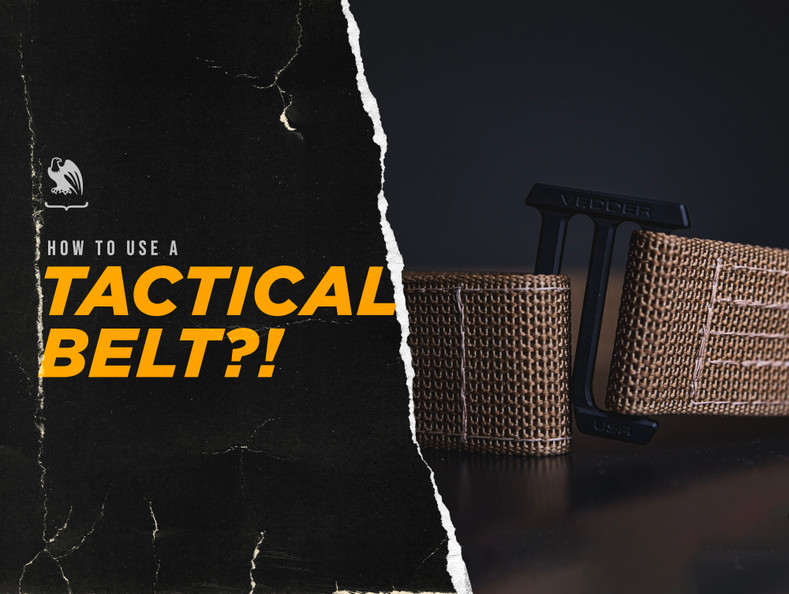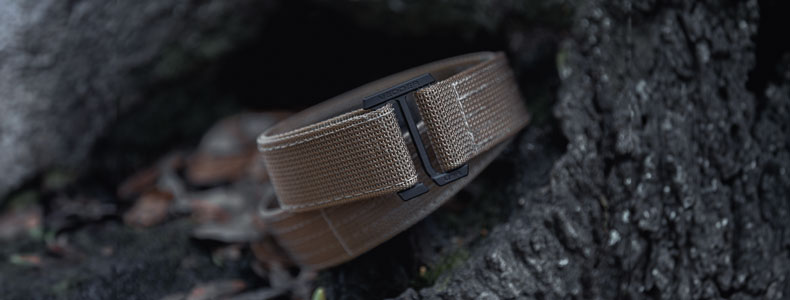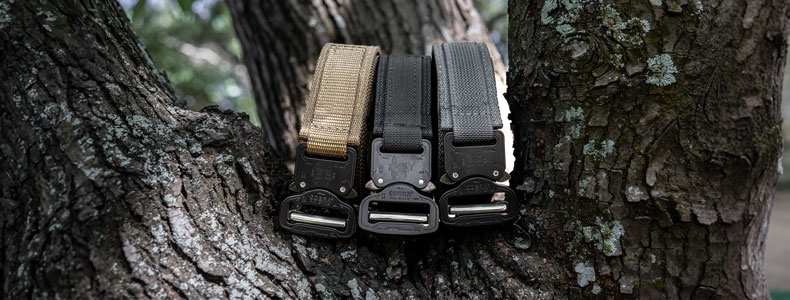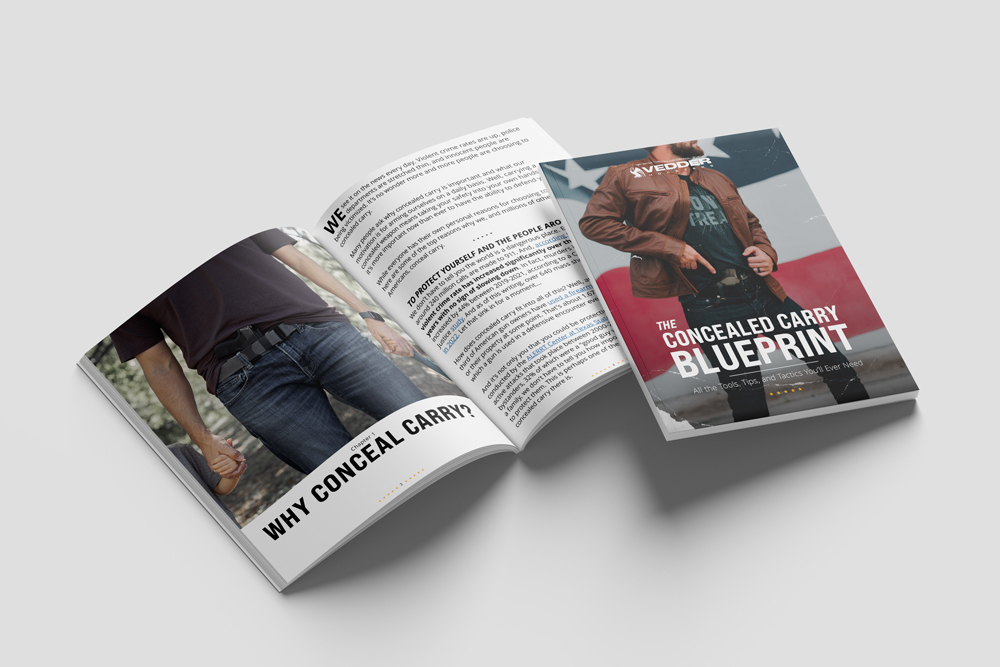How to Use: Tactical Belt

We all love that word, tactical… it rolls right off the tongue, doesn’t it? But what exactly is a tactical belt, and how do you use one?
Tactical belts are designed to carry all your everyday essentials like holsters, knives, spare magazines, and anything else you need easy access to.
But, like most things, these belts have many different uses and styles. So, how do you know which one is right for you? And how do you get the most out of this essential piece of EDC gear? Whether you’re looking for something to make concealed carry easier or trying to set up the perfect “battle belt,” you’ve come to the right place.
Let’s start with the basics.
Products Mentioned In This Article
What is a Tactical Belt?

Tactical gun belts are not a new concept. The ancient Roman soldiers used belts to carry swords, pouches of water, and other gear thousands of years before the phrase “everyday carry” was coined.
Today, military personnel still use belts designed strong enough to support the weight of all their combat gear. (Hence the term “battle belt.”) And soldiers aren’t the only ones who use them.
You’ve probably seen law enforcement officers wear tactical duty belts as part of their uniform; it’s where they keep their sidearm, handcuffs, pepper spray, radio, and everything else they need to carry to do their job.
Beyond that, many people in the firearms community also use tactical-style belts for concealed carry or competition shooting. These belts are designed to support the weight of your EDC gear, keep your pants up, AND look good.
There are a number of different kinds of tactical belts designed for a variety of functions. Let’s take a look at some of the available options.
Types of Tactical Belts
Many different types of belts fall under the “tactical belt” umbrella. The three most common kinds are duty belts, EDC belts, and rigger’s belts.
Duty Belt

A duty belt is exactly what it sounds like. It’s specifically designed for military and law enforcement personnel to wear while on duty and serves as one of the most important parts of their uniform. For police, these belts typically hold a firearm, pepper spray, radio, handcuffs, flashlight, taser, and other on the job essentials.
These belts are the largest in the tactical-style gun belt family, usually 2 inches wide or larger, and come in two parts: an inner belt and an outer belt. A quality inner belt, like our Inner Gun Belt here at Vedder Holsters, is threaded through your belt loops for stability. An outer belt, which is the part that gear is strapped to, is then velcroed over the top of the inner belt, allowing for easy and secure application.
EDC Belt

Everyday carry (EDC) belts are a more low-profile belt and are the most popular choice for concealed carry. They are designed to be strong enough to support the weight of a pistol, magazine, knife, and any other gear you carry in your day-to-day, all while maintaining a thin, minimalist look that can easily disappear under a shirt.
These kinds of belts are usually the thinnest of the tactical-style belts, generally measuring around 1.5 inches wide to eliminate bulk. But don’t let their smaller size fool you. These belts are as tough as they come!
Our Vedder Holsters V3 Gun Belt and Cobra® Quick Release Gun Belt are made in America using premium, extra-stiff dual-layered nylon webbing. Both belts are designed so that you don’t have to worry about readjusting your belt every time you put it on, which is just one of the many things that make these belts stand out from the rest.
For a deep dive on the differences between the V3 and Cobra gun belts and for information on how to choose the right one for you, check out this article that talks all about it.
Rigger’s Belt
If you’re looking for the best of both worlds, a rigger’s belt might be for you. These belts measure around 1.75 inches wide, making them the perfect medium.
Rigger’s belts were actually designed for rappelling, which proves just how strong they are. They are usually built with a ‘V’ or ‘D’ ring to clip a carabiner or helo retention lanyard to (though they can be used for other things, obviously). When it comes to shooting sports, these belts are often used in competitions or at the range for training. They’re not quite big enough to serve the purpose of a duty belt, yet not quite as small as an EDC belt.
Who Needs a Tactical Belt
The real question is, who doesn’t need a tactical belt?
All kidding aside, there are a few applications in which tactical gun belts really shine. Other than police officers and military personnel, who HAVE to wear one as part of their uniform, tactical belts are great for anyone who wants to carry a firearm.
More specifically, tactical-style belts (or at least some sort of gun belt) are essential for any type of concealed carrying around your waist. Whether you’re carrying inside the waistband or outside the waistband, you’ll need a belt with enough stiffness to prevent your pistol and holster from causing “belt sag™”.
Tactical-style belts are also great for anyone training at the range or participating in shooting competitions. In both cases, you’ll need to be able to quickly holster and draw your firearm, and a quality tactical-style belt can both give you the secure foundation you need and allow you to carry extra things like spare magazines so you can burn through more rounds.
So, to answer the question of who needs a tactical gun belt, the answer is you.
Tips for Battle Belt Setup

While most people keep their belt setup simple, carrying just their IWB or OWB holster, firearm, and maybe a spare magazine or two, there has been a rise in popularity over the years in what’s known as a “battle belt,” “war belt,” or “gunfighter belt.”
Essentially, a battle belt is a tactical belt that is set up with all kinds of gear you may need in an armed conflict. While there are tons of opinions out there on what exactly you should carry on a battle belt, most enthusiests agree on a few essentials.
First and foremost, you’ll need a holster. Because in a battle you need to be able to run and maneuver without worrying about your weapon falling out, a Kydex OWB holster is the way to go. These holsters are built to fit your precise gun model and typically come with adjustable retention so you can make sure your gun stays put. We have a variety of OWB holsters here at Vedder Holsters, all of which are designed to pair well with a gunfighter belt.
Another option to consider, though it isn’t necessary, is the addition of a thigh strap. These straps wrap around your upper thigh and connect to your tactical belt, providing additional support to your firearm. It helps keep your holster in place as you draw and keeps your pistol secure against your body as you run, kneal, or squat down.
The second essential item for a war belt is spare magazines. After all, in the heat of the moment, there’s a good chance you may need some extra ammo. Some people carry two extra magazines, some more. The amount of extra ammo you feel is necessary is really up to you and what exactly you’re trying to prepare for (are you gearing up for the apocalypse or for a day at the range?). Vedder Holsters offers four different types of magazine holsters, including single, double, and PMAG holsters.

Another thing most battle belt preppers like Grant LaVelle of Gunspot Academy insist on is a first aid kit containing emergency medial items like gauze, tournaquits, and blood stopping powder.
“The med kit … is super important,” LaVelle said in a video for The Armory Life. “I generally will have that within reach of my dominant shooting hand so that I can retrieve that fairly easy.”
In addition to those core items, many battle belt enthusiasts will include a dump pouch to collect their empty mags in, a knife, a multitool, a flashlight or glowsticks, and extra pouches for any other random things they may want (a granola bar, a rosary, a photo of your dog Rex, whatever is deemed “essential” by you).
One thing to keep in mind is the placement of your items. Military influencer Mike Jones of Garand Thumb recommends avoiding putting too much on the backside of your battle belt to prevent back strain. He also suggests keeping the very front of your war belt open in the case you need to lay prone.
“Going prone is an often overlooked part of battle belts,” he said. “If you have too much s*** out front, it’s going to make it more difficult to go prone.”
At the end of the day, whatever you choose to include on your battle belt is up to you. Just make sure to actively train with your belt so that in case the unthinkable happens, you are ready.
Things to Look for in a Tactical Belt
When it comes to your EDC setup, the belt you choose is one of the most critical aspects. After all, it is the foundation of everything you will put on it. When looking for a quality tactical gun belt, you’ll want to make sure you get one that is rigid enough to hold your gear yet flexible enough to be comfortable and allow you to move without crushing your diaphragm.
Durability
Choosing a material isn’t hard as the vast majority of tactical belts are made from nylon. However, it is important to look for one that is made from dual layers of nylon webbing. These belts should be stitched together, not glued, so you know they’ll be extra durable and last a long time.
Rigidity
When it comes to rigidity, it’s important to find a belt that is strong enough not to sag under the weight of your gun, but flexible enough to be comfortable. The amount of rigidity that you need will depend on the weight of your gun and how many other items you want to carry. For a full-on war belt, you’ll want one with firmer rigidity while if you’re concealing a smaller weapon you can get away with more give.
Buckle
Buckles are not only stylish, but they’re also an important aspect of an EDC belt. It’s important to choose a tactical belt buckle that is strong, adjustable, and secure. At Vedder Holsters, we have a couple of different belt options with different buckle choices.
Our Cobra® Quick Release Gun Belt comes equipped with a step-down buckle that securely snaps into place. It also eliminates the need to readjust your belt each time you put it on since it clicks together instead of being threaded through a traditional buckle.
The Vedder Holsters V3 Gun Belt is a more low-profile buckle. Instead of clicking together, the machined 7075 billet aluminum buckle easily slides together, firmly securing your belt and the EDC gear you attach to it. Like the Cobra, there is no need to readjust this belt every time you put it on thanks to the buckles convenient design.
How do I Know What Size Tactical Belt I Need?
One of the most essential factors in finding a quality tactical gun belt is getting one that fits like a glove. Otherwise, it will probably be tight and uncomfortable, or it will be too loose and sag. Either way, not a good thing when it comes to gun belts (or any belts, really).
The best way to determine your belt size is by using a belt you currently own as a reference. Try on your regular belt and see if you can fit your (unloaded, of course) pistol and holster inside your waistband and still cinch up the belt comfortably. It shouldn’t be too tight or too loose. To take the wise words of Goldilocks, it should be “just right.”
Once you’ve got it right, take note of where the ends of your belt meet and remove it. Measure from the base of the buckle (NOT the tip) to where the other end was when you were wearing it. This will tell you your belt size. It should be about four inches larger than your pant size.
And don’t worry if you don’t get it exactly perfect. Most belts have a little wiggle room and adjustable features to accommodate different-sized guns and body types.
For more information on this topic, visit any one of our belt product pages for more in-depth sizing instructions, including a helpful video.
Is a Tactical Belt Right for Me?

Anyone can wear a tactical-style belt. It really just depends on your personal taste.
If you like the tactical look, there’s no doubt about it; an EDC belt would be a great fit for you. If you prefer something that does the same job with a sleeker, more fashionable look, a leather gun belt may be a better fit.
Our Polymer Core Leather Gun Belt is known for its stylish design. It’s rugged enough for the ranch and sleek enough for the boardroom, thanks to its premium cowhide and gunmetal matte finished buckle.
At the end of the day, it doesn’t matter what style of EDC belt you choose, just so long as you have one. Trying to use a regular belt to support your carry system will more than likely result in nothing but frustration. Standard belts are not built to be as sturdy as gun belts and will sag under the weight of your pistol, let alone a full battle belt setup.
So if you’re looking to concealed carry, practice your draw at the range, or sign up for some competition shooting, a tactical belt will be a great addition to your setup.
Summary
Tactical belts are designed to do it all. Their sturdy, webbed nylon build allows them to hold everything from guns, to knives, to, well, anything really.
Whether you’re looking for a quality EDC belt or you want to go hardcore with a battle belt, there’s a tactical belt for you.
If you’re looking for belts or holsters, we recommend visiting our Holsters by Gun Model page if you are looking for holsters that are custom-made for your weapon of choice. For all of our belt and holster options and for more information to help you choose the carry system that works best for you, visit our Vedder Holsters website.
Looking for items beyond holsters and belts, check out our Resources Page for popular product links like lights, lasers, first aid, maintenance, and more.
*This page contains affiliate links. When you purchase a product included on this list, we receive a commission at no extra cost to you.



